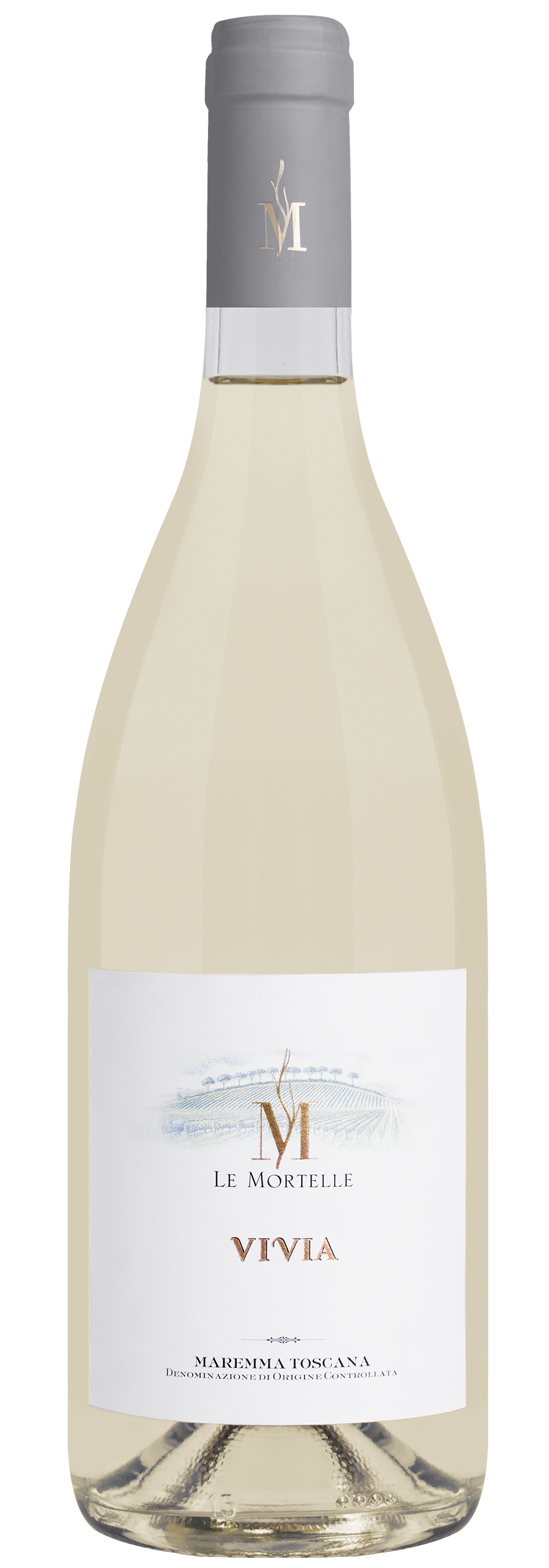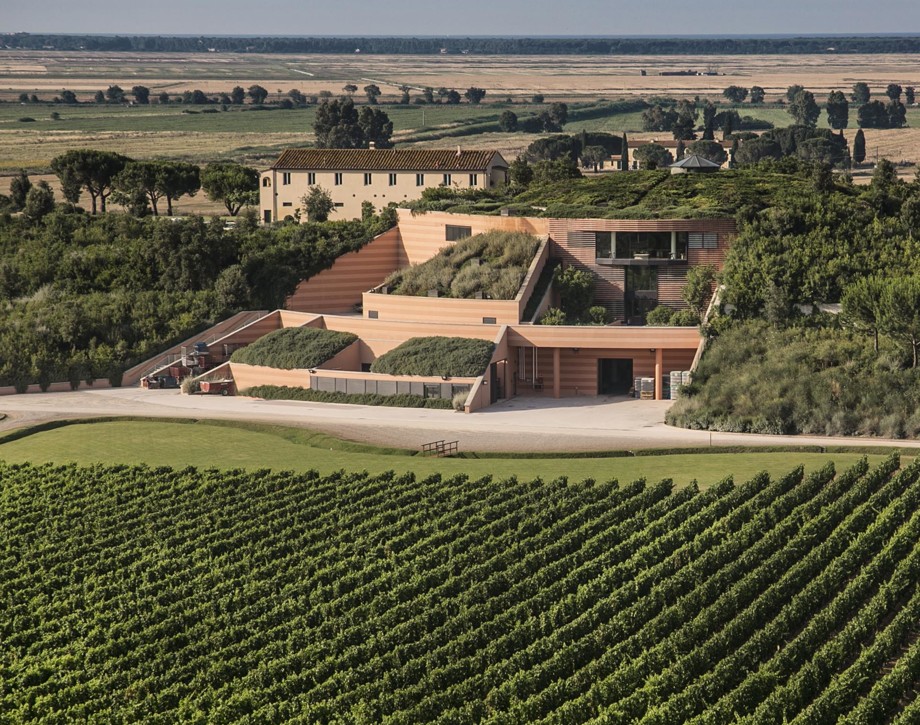Vivia

Climate
The 2018 growing season experienced under average temperatures during winter and spring with frequent rainfall. These climatic conditions abundantly replenished groundwater reserves in the soil favoring a regular vegetative cycle and excellent fruit set. In general, summer months were hot. Selective grapevine defoliation during the month of June and cluster thinning promptly at the beginning of August ensured an excellent balance in the vine’s growth cycle and perfect berry ripening. Harvest was slightly delayed compared to past seasons, it began the last day of August with Viognier, whose fruit revealed particularly fragrant aromas and continued mid September with Vermentino, characterized by vibrant notes and hints of citrus fruits. Harvesting came to a conclusion with Ansonica, a variety whose grapes are able to impart structure and aromatic qualities, during the first few days of October.
Vinification
Upon arrival in the cellar, the grapes were gently pressed and each grape variety was fermented separately to maintain and accentuate its own unique characteristics. The must was then cooled down to a controlled temperature of 10° C (50°F) for 24 hours to favor a natural settling of the impurities. The clarified must was then transferred to temperature controlled stainless steel tanks for alcoholic fermentation at 16°C (61° F). Vivia was aged on the lees for a short period in stainless steel tanks for approximately three months before being bottled in January 2019.
Historical Data
The Mortelle estate is in the heart of Maremma in Tuscany, near the town of Castiglione della Pescaia set in an extraordinary and fascinating position both for the territory’s unparalleled natural beauty and its historical heritage and culture. The Antinori family has been part of this territory for generations. Evidence of ownership of land in this area is recorded on a property deed dated 1863. It states their ownership of Poggio Franco, one of the best vineyards on the estate, together with other parcels of land. Since 1999, when the property was acquired, the family has dedicated their efforts to improving the vineyards and building the new winery with the firm belief that this area, slowly emerging on the Italian viticultural horizon, has great potential for the production of high quality wines. Varieties grown in this area can fully express their own characteristics as well as the exceptional qualities of the terroir. The soil is of medium consistency, sandy and loamy composed of clay and silica and in some parts of the estate is rich in rocky deposits. Vermentino and Ansonica, typical grape varieties cultivated in Tuscany’s costal area, grow alongside Viognier, a vine that has recently been planted after years of patient research to produce an elegant white wine expressing the colors and aromas of the Maremma coastline.
Tasting Notes
Vivia 2018 is bright straw yellow in color with greenish hues. On the nose it is pleasing and intense. Aromas of white peaches, pineapple and lemon create a harmonious bouquet complemented by hints of white lime blossoms. On the palate the wine is creamy and mineral ending with a finish of fresh aromatic Mediterranean herbs and citrus fruit.

The Wine
This wine is harvested from vineyards indigenous to the Tuscan coast, a blend of Vermentino and Viognier and a small percentage of Ansonica: a successful result of patient research that produced an elegant white wine expressing the colors and aromas of the Maremma coastline.

Climate
The 2018 growing season experienced under average temperatures during winter and spring with frequent rainfall. These climatic conditions abundantly replenished groundwater reserves in the soil favoring a regular vegetative cycle and excellent fruit set. In general, summer months were hot. Selective grapevine defoliation during the month of June and cluster thinning promptly at the beginning of August ensured an excellent balance in the vine’s growth cycle and perfect berry ripening. Harvest was slightly delayed compared to past seasons, it began the last day of August with Viognier, whose fruit revealed particularly fragrant aromas and continued mid September with Vermentino, characterized by vibrant notes and hints of citrus fruits. Harvesting came to a conclusion with Ansonica, a variety whose grapes are able to impart structure and aromatic qualities, during the first few days of October.
Vinification
Upon arrival in the cellar, the grapes were gently pressed and each grape variety was fermented separately to maintain and accentuate its own unique characteristics. The must was then cooled down to a controlled temperature of 10° C (50°F) for 24 hours to favor a natural settling of the impurities. The clarified must was then transferred to temperature controlled stainless steel tanks for alcoholic fermentation at 16°C (61° F). Vivia was aged on the lees for a short period in stainless steel tanks for approximately three months before being bottled in January 2019.
Historical Data
The Mortelle estate is in the heart of Maremma in Tuscany, near the town of Castiglione della Pescaia set in an extraordinary and fascinating position both for the territory’s unparalleled natural beauty and its historical heritage and culture. The Antinori family has been part of this territory for generations. Evidence of ownership of land in this area is recorded on a property deed dated 1863. It states their ownership of Poggio Franco, one of the best vineyards on the estate, together with other parcels of land. Since 1999, when the property was acquired, the family has dedicated their efforts to improving the vineyards and building the new winery with the firm belief that this area, slowly emerging on the Italian viticultural horizon, has great potential for the production of high quality wines. Varieties grown in this area can fully express their own characteristics as well as the exceptional qualities of the terroir. The soil is of medium consistency, sandy and loamy composed of clay and silica and in some parts of the estate is rich in rocky deposits. Vermentino and Ansonica, typical grape varieties cultivated in Tuscany’s costal area, grow alongside Viognier, a vine that has recently been planted after years of patient research to produce an elegant white wine expressing the colors and aromas of the Maremma coastline.
Tasting Notes
Vivia 2018 is bright straw yellow in color with greenish hues. On the nose it is pleasing and intense. Aromas of white peaches, pineapple and lemon create a harmonious bouquet complemented by hints of white lime blossoms. On the palate the wine is creamy and mineral ending with a finish of fresh aromatic Mediterranean herbs and citrus fruit.

Fattoria Le Mortelle
The Mortelle estate is in the heart of Maremma in Tuscany, near the town of Castiglione della Pescaia set in an extraordinary and fascinating position both for the territory’s unparalleled natural beauty and its historical heritage and culture. The Antinori family has been part of this territory for generations. Evidence of ownership of land in this area is recorded on a property deed dated 1863. It states their ownership of Poggio Franco, one of the best vineyards on the estate, together with other parcels of land. Since 1999, when the property was acquired, the family has dedicated their efforts to improving the vineyards and building the new winery with the firm belief that this area, slowly emerging on the Italian viticultural horizon, has great potential for the production of high quality wines. Varieties grown in this area can fully express their own characteristics as well as the exceptional qualities of the terroir. The property extends over an area of 270 hectares (667 acres) 170 of which (420 acres) are planted with vineyards of Cabernet Sauvignon, Cabernet Franc and other more recently planted vineyards with white grape varieties such as Vermentino, Ansonica, Viognier and a small parcel of Carménère. The soil is of medium consistency, sandy and loamy composed of clay and silica and in some parts of the estate is rich in rocky deposits.

Soil
Loamy soil with sand and silt.
















